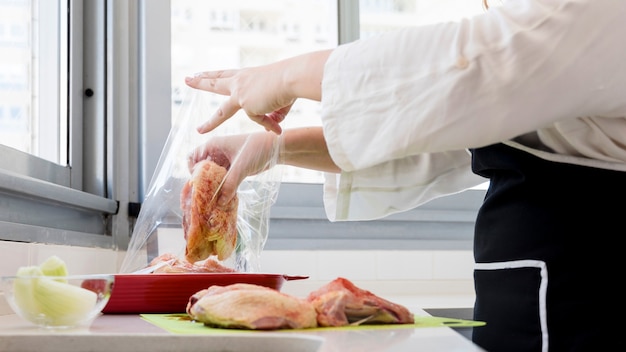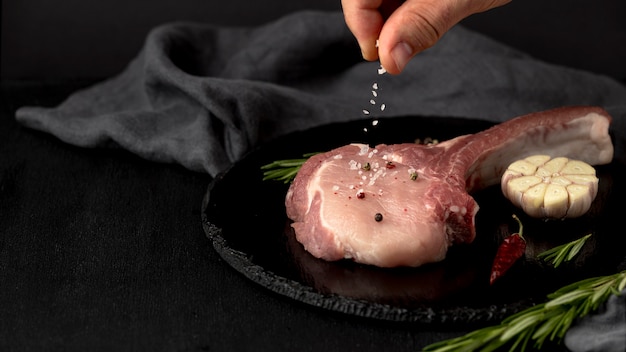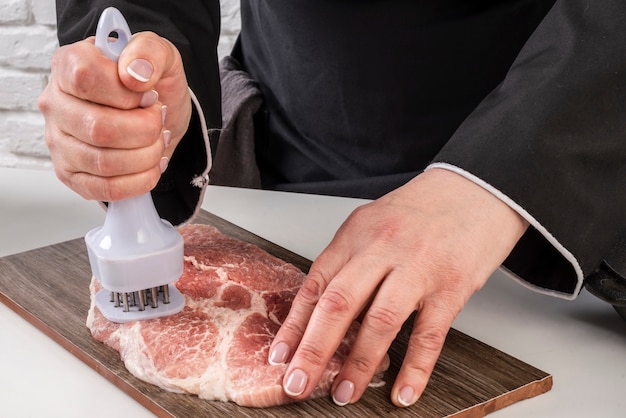Alright, let's talk pork chops! There's something truly satisfying about a perfectly cooked pork chop, juicy, tender, and with a delicious crispy exterior. But figuring out how long to cook them can feel like navigating a culinary maze. You don't want to end up with a dry, tough piece of meat, right?
Don't worry, my culinary adventurers! I'm here to guide you through the ins and outs of pork chop cooking time. We'll be diving into everything from choosing the perfect chop to mastering different cooking methods, and of course, we'll be tackling the crucial question of how long to cook those beauties. So grab your apron, sharpen your knives, and let's get started!
(Part 1) The Pork Chop: Picking the Perfect One

Before we even think about the oven or the pan, we need to pick the right pork chop. Think of it like choosing the perfect ingredient for your masterpiece. You've got options, and each one has its own personality and quirks.
1. Bone-In vs. Boneless: A Tale of Two Chops
First things first, bone-in or boneless? This is a classic culinary dilemma, like choosing between a cozy fireplace and a roaring bonfire.
Bone-in: These chops are a bit more traditional, like a timeless classic song. The bone adds a lovely depth of flavor, as if the meat is whispering secrets from the past. You also get a bit more meat clinging to the bone, which is fantastic if you're feeding a hungry crowd. However, they do take a bit longer to cook because the bone holds onto heat like a stubborn old friend.
Boneless: These are your quick and easy option, like a modern pop song, catchy and straight to the point. They cook faster, and they're perfect for smaller portions or for those who prefer to avoid the bone-wrestling.
2. Thickness: A Matter of Time
Next up, thickness. Think of it like choosing the perfect slice of bread – thin for a quick snack or thick for a substantial meal.
Thin: These are ideal for a quick, weeknight dinner, like a burst of energy. They cook up fast, but you need to keep a watchful eye to avoid overcooking.
Thick: Now we're talking about something substantial, like a hearty stew. Thick chops take a bit longer to cook through, but they offer a more rewarding experience. It's like a delicious, juicy hug.
3. The Cut: Knowing Your Options
Finally, the cut. You're probably used to seeing "pork loin chops" or "pork rib chops" at the butcher's, but there are a few different cuts to consider.
Loin Chop: These are the most common, like the popular song everyone knows. They're relatively lean and tend to be more tender than other cuts. You'll find them as bone-in or boneless.
Rib Chop: These are a bit more marbled than loin chops, like a song with a little more richness and complexity. This means they're a bit richer in flavor. They can be a bit tougher, but they're fantastic for grilling, where the heat helps to break down the tougher fibers.
center cut Chop: This is a specific part of the loin, like a special edition of a classic song. It's known for being extra tender and juicy, a true delight for the palate. They're a bit more expensive, but they're worth it if you're looking for the ultimate pork chop experience.
(Part 2) Mastering the Basics: Cooking Methods Unveiled

Now that you've got your perfect pork chop, it's time to talk about the fundamental ways to cook them. We'll be exploring the world of oven roasting, pan-frying, and grilling, and I'll share some of my own personal secrets for achieving juicy, flavorful pork chops every time.
1. Oven Roasting: The Classic Approach
Let's start with the reliable classic: oven roasting. It's simple, forgiving, and a fantastic way to cook a bunch of chops at once. Think of it as a warm and cozy hug from the oven.
Oven roasting tips:
Pre-heat your oven to 375°F (190°C). This ensures even and quick cooking, like a well-rehearsed symphony.
Season generously with salt and pepper. Don't be shy with the seasoning! This is your chance to create a flavor profile that will dance on your tongue. I love to add a good pinch of smoked paprika for a bit of smoky depth, like a whisper of campfire stories.
Place the pork chops on a baking sheet lined with parchment paper. This will make cleanup a breeze, a true lifesaver after a delicious meal.
Roast for 15-20 minutes for thin chops, or 20-25 minutes for thick chops. Remember, these are just guidelines. The cooking time will vary depending on the thickness of your chops and the heat of your oven. It's a bit like listening to music – you have to adjust the tempo to fit the situation.
Use a meat thermometer to check for doneness. This is the key to avoiding overcooked and dry meat. Insert the thermometer into the thickest part of the chop, and make sure it reaches an internal temperature of 145°F (63°C) for safe consumption.
2. Pan-Frying: Quick, Easy, and Delicious
Pan-frying is a great way to get a beautiful sear on your pork chops. It's quick, easy, and perfect for those weeknight dinners when you need a satisfying meal without a lot of fuss. It's like a quick and exciting adventure, delivering a burst of flavor.
Pan-frying Tips:
Heat a heavy-bottomed pan over medium-high heat. A cast-iron pan is ideal, like a trusted old friend, but you can also use a stainless steel pan.
Add a tablespoon or two of oil to the pan. I prefer to use a neutral oil like vegetable oil or canola oil.
Season the pork chops with salt and pepper, then pat them dry with paper towels. This helps ensure a nice, crispy crust, like a perfect layer of protection.
Cook the pork chops for 3-5 minutes per side. Flip the chops once they've developed a nice brown crust. Listen to the sizzle! It's a symphony of deliciousness.
Reduce the heat to low and continue cooking for another 3-5 minutes per side, or until the internal temperature reaches 145°F (63°C). You can use a meat thermometer to check the temperature, or you can use the "finger test" if you're feeling adventurous.
3. Grilling: Outdoor Flavor and Smoky Aroma
Finally, we have grilling! There's something magical about the smoky flavor that comes from grilling, and it's perfect for those summer evenings when you want to enjoy the outdoors. It's like an outdoor concert, with the aroma of smoke filling the air.
grilling tips:
Preheat your grill to medium-high heat. You want your grill to be hot enough to sear the pork chops but not so hot that they burn.
Season the pork chops with salt and pepper. You can also add other herbs and spices, but don't go overboard. Let the pork shine!
Place the pork chops on the grill and cook for 4-6 minutes per side. Flip the chops once they've developed a nice grill mark, like a signature on a masterpiece.
Reduce the heat to medium and continue cooking for another 2-4 minutes per side, or until the internal temperature reaches 145°F (63°C). Make sure to use a meat thermometer to check the temperature.
Let the pork chops rest for 5-10 minutes before slicing and serving. This allows the juices to redistribute, resulting in a more juicy and tender chop. It's like letting a song breathe, giving it time to reveal its full beauty.
(Part 3) Cooking Time: The Breakdown

Now that you've got a grasp on the basics, let's talk about cooking time. This is the heart of the matter, isn't it?
1. The Importance of Thickness: Time is Relative
I've mentioned it before, but it bears repeating: thickness is king when it comes to pork chop cooking time. Think of it like a marathon – a thin chop is like a sprinter, while a thick chop is like a long-distance runner.
2. General Cooking Time Guidelines: A Starting Point
Here's a general table to help you estimate the cooking time for your pork chops. It's a roadmap to your culinary success.
| Chop Thickness | Oven Roasting | Pan-frying | Grilling |
|---|---|---|---|
| Thin (1/2 inch) | 15-20 minutes | 5-7 minutes total | 6-8 minutes total |
| Medium (1 inch) | 20-25 minutes | 8-10 minutes total | 8-10 minutes total |
| Thick (1 1/2 inches) | 25-30 minutes | 10-12 minutes total | 10-12 minutes total |
3. Beyond the Guidelines: Flexibility and Intuition
Remember, these are just guidelines. Your oven, your pan, and your grill all have their own personalities, their own quirks. It's like different musical instruments – they each have their own unique sound. It's important to use a meat thermometer to check for doneness, like tuning your instrument to ensure the perfect harmony of flavors.
4. The "Finger Test": A Culinary Adventure
If you're feeling adventurous, you can try the "finger test" to check for doneness. Press the center of the pork chop with your finger. If it feels firm and springy, it's done. If it feels soft and squishy, it needs more cooking. It's like testing the texture of a piece of music – you can feel the rhythm and the beat.
(Part 4) Doneness: The Art of Knowing When to Stop
We've talked about cooking time, but the real test of a good pork chop is its doneness. You want it to be juicy, tender, and flavorful, but you also want to make sure it's safe to eat. This is the climax of our culinary journey, where we reach the point of perfection.
1. Internal Temperature: The Safe Zone
The Food Standards Agency recommends cooking pork chops to an internal temperature of 145°F (63°C). This ensures that any harmful bacteria are killed, like a powerful symphony of heat that vanquishes any unwanted guests.
2. Visual Clues: Seeing is Believing
You can also use visual clues to gauge doneness. Look for these signs:
Color: The pork chop should be a pale pink color when it's done. If it's still pink in the center, it needs more cooking. It's like a subtle shift in color, a gentle whisper of change.
Juices: The juices should run clear when you cut into the pork chop. If they're still red, it needs more cooking. It's like the clearing of the clouds, revealing a bright and clear sky.
Texture: The pork chop should feel firm and springy when you press on it. If it feels soft and squishy, it needs more cooking. It's like the rhythm of a heartbeat, strong and steady.
(Part 5) Resting: The Secret to Juicy Success
Once your pork chops are cooked to perfection, it's time to give them a little break. Resting allows the juices to redistribute throughout the meat, resulting in a more juicy and tender chop. Think of it as a pause between movements in a symphony, allowing the music to resonate.
1. How Long to Rest: Patience is a Virtue
Let your pork chops rest for 5-10 minutes before slicing and serving. This gives the juices a chance to settle back in, preventing your chops from drying out. It's like letting a song fade out, allowing the final notes to linger in the air.
2. The Importance of Patience: Good Things Come to Those Who Wait
I know it's tempting to dig in right away, but trust me, a little patience goes a long way. Resting your pork chops will transform them from good to great. It's like letting a story unfold, allowing the suspense to build and the climax to be even more satisfying.
(Part 6) Topping It Off: Flavors and Finishes
Now that your pork chops are cooked to perfection, it's time to add the finishing touches. There are endless possibilities for toppings, from simple sauces to fresh herbs, so get creative! This is the final flourish, the last touch that elevates your culinary masterpiece.
1. Sauces and Glazes: A Symphony of Flavors
Apple Sauce: A classic pairing for pork chops, apple sauce adds a touch of sweetness and tartness, like a gentle harmony of contrasting flavors.
Mustard Sauce: A simple mustard sauce made with Dijon mustard, honey, and lemon juice is a delicious and tangy option, a burst of bright and bold notes.
bbq sauce: For a smoky and savory flavor, try slathering your pork chops with BBQ sauce during the last few minutes of cooking. It's a smoky serenade for your taste buds.
Pan Sauce: Don't throw away that delicious pan drippings! Deglaze the pan with a bit of wine or broth and make a quick pan sauce to drizzle over your pork chops. This is like adding a special instrumental bridge to your culinary symphony.
2. Fresh Herbs: A Touch of Aromatic Elegance
Rosemary: Rosemary has a strong, piney flavor that complements pork beautifully, like a rich and earthy counterpoint. Add sprigs of rosemary to the grill or pan while cooking, or chop some fresh rosemary and sprinkle it over your finished chops.
Sage: Sage has a slightly peppery flavor that goes well with pork, like a touch of spice to add complexity. You can add fresh sage leaves to the grill or pan while cooking, or chop some fresh sage and sprinkle it over your finished chops.
Thyme: Thyme has a delicate, earthy flavor that complements pork perfectly, like a gentle and understated melody. Add sprigs of thyme to the grill or pan while cooking, or chop some fresh thyme and sprinkle it over your finished chops.
(Part 7) side dish Pairings: Harmonies of Flavor
Now, let's talk sides! You've got your perfectly cooked pork chops, but you need something to round out the meal, right? Here are some side dish ideas that are guaranteed to make your pork chops sing. This is the supporting cast, the ensemble that enhances the main performance.
1. Classic Sides: The Familiar and Beloved
mashed potatoes: Creamy and comforting, mashed potatoes are a classic side dish for pork chops, a dependable and beloved companion.
Roasted Vegetables: Roasted vegetables, like carrots, Brussels sprouts, or asparagus, add a touch of sweetness and color to your plate, a vibrant and colorful chorus.
green beans: Simple, healthy, and delicious, green beans are a perfect accompaniment to pork chops, a light and refreshing counterpoint.
2. Creative Sides: Stepping Outside the Box
sweet potato Fries: For a sweet and savory side dish, try sweet potato fries, a delightful twist on a classic.
Couscous Salad: A couscous salad with fresh herbs and vegetables is a light and flavorful option, a refreshing and elegant variation.
Apple Slaw: A crisp and refreshing apple slaw with a tangy vinaigrette is a perfect complement to pork chops, a bright and tangy counterpoint.
(Part 8) FAQs: Addressing Your Culinary Queries
Now, let's address some of the burning questions you might have. This is the Q&A session, where we delve deeper into the intricacies of pork chop cooking.
1. Can I cook pork chops From Frozen?
You can, but it's not ideal. It'll take longer to cook, and the texture might be a bit tough, like a song that's been played too many times. For the best results, thaw your pork chops in the refrigerator overnight.
2. How Do I Tell if Pork Chops are Done Without a Thermometer?
You can use the "finger test" described earlier, but it's not the most accurate method. The best way to check for doneness is to use a meat thermometer, like a skilled conductor using a baton to guide the orchestra.
3. What Happens If I Overcook Pork Chops?
If you overcook pork chops, they will be dry and tough, like a song that's lost its melody. If you're worried about overcooking, you can always take them off the heat a little early and let them rest.
4. Can I Reheat Pork Chops?
Yes, you can reheat pork chops. The best way to reheat them is in the oven at a low temperature, like a gentle warmth that brings the music back to life. You can also reheat them in a pan on the stovetop, but be careful not to overcook them.
5. How Long Can I Keep Cooked Pork Chops in the Fridge?
Cooked pork chops can be kept in the refrigerator for 3-4 days. Make sure to store them in an airtight container or wrap them tightly in plastic wrap. This is like preserving a musical masterpiece for future enjoyment.
(Part 9) Final Thoughts: Embrace the Adventure
Well, there you have it! A comprehensive guide to pork chop cooking time, from choosing the right chop to mastering different cooking methods and even topping them with your favorite flavors. Remember, it’s all about finding the right balance between doneness and tenderness, like a well-balanced musical composition. So, get out there, experiment, and enjoy the deliciousness of a perfectly cooked pork chop! Let me know if you have any other questions, and happy cooking!
Everyone is watching

Corn on the Cob: The Ultimate Guide to Perfectly Cooked Ears
Healthy MealsAh, corn on the cob. Just the name evokes images of sunny days, barbecues, and that sweet, juicy flavour that ...

Perfect Pork Roast Oven Cooking Time: A Guide to Delicious Results
Healthy MealsThere's something truly satisfying about a perfectly roasted pork. The aroma alone is enough to make your mout...

Ham Cooking Time: How Long to Bake, Smoke, or Boil a Delicious Ham
Healthy MealsAh, ham. It's a classic, isn't it? A real crowd-pleaser, especially around holidays. And when done right, it'...

Scallops: The Ultimate Guide to Perfect Cooking
Healthy MealsAh, scallops. Those delicate, sweet, and utterly delicious morsels of the sea. They hold a special place in my...

Spaghetti Squash: The Ultimate Guide to Cooking and Serving
Healthy MealsRemember that time you saw spaghetti squash at the supermarket, looking all bumpy and strange, and thought, "W...
